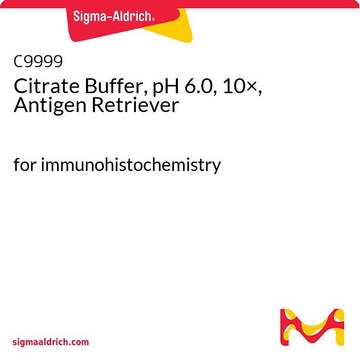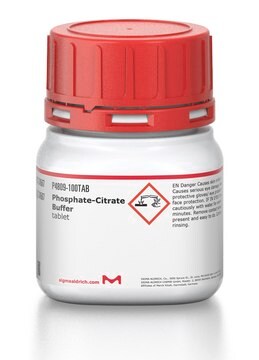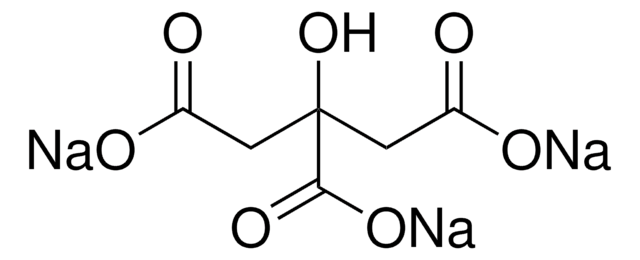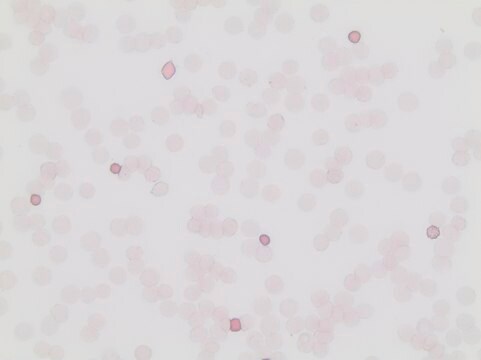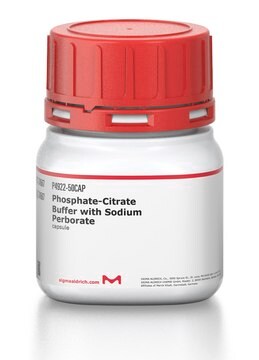C2488
Citrate Buffer Solution, 0.09 M
Synonym(s):
Citric Acid Buffer Solution
Sign Into View Organizational & Contract Pricing
All Photos(1)
About This Item
UNSPSC Code:
12161700
eCl@ss:
32129211
NACRES:
NA.25
Recommended Products
description
Contains 1% chloroform
pH 4.8 at 25 °C.
Quality Level
form
solution
concentration
0.09 M
pH
4.8 (25 °C)
application(s)
diagnostic assay manufacturing
storage temp.
2-8°C
Related Categories
General description
Citrate Buffer Solution, 0.09 M, is a high-quality biochemical buffer solution commonly employed in various research applications. Its applications include use in acid phosphatase reactions alongside p-nitrophenyl phosphate (pNPP) enzyme substrate. Citrate Buffer is also used for the isolation of RNA from cells and tissues. In addition, it is also used as a background electrolyte for separating sulfonamides utilizing capillary zone electrophoresis. With its superior buffering capacity and ability to maintain a stable pH, Citrate Buffer Solution, 0.09 M is an excellent choice for any researcher in need of reliable performance.
Application
Citrate Buffer Solution, 0.09 M has been used as a heat-induced antigen retriever on formalin-fixed paraffin-embedded (FFPE) tissue sections during immunohistochemistry (IHC) experiments. It has also been used in the preparation of hybridization solutions for fluorescence in situ hybridization (FISH) procedures.
Other Notes
Unit definition: One unit of acid phosphatase will hydrolyze 1.0 μmole of p-nitrophenyl phosphate per, minute at pH 4.8 at 37 °C.
Signal Word
Warning
Hazard Statements
Precautionary Statements
Hazard Classifications
Carc. 2 - STOT RE 2 Oral
Target Organs
Liver,Kidney
Storage Class Code
12 - Non Combustible Liquids
WGK
WGK 2
Flash Point(F)
Not applicable
Flash Point(C)
Not applicable
Personal Protective Equipment
dust mask type N95 (US), Eyeshields, Gloves
Choose from one of the most recent versions:
Already Own This Product?
Find documentation for the products that you have recently purchased in the Document Library.
Customers Also Viewed
I Gkouveris et al.
Histology and histopathology, 32(10), 1065-1076 (2017-01-17)
Signal transducer and activator of transcription 3 (STAT3) and mitogen activated protein kinases (MAPKs), including ERK and JNK, have been implicated in oral squamous cell carcinoma (OSCC) development and progression. Our purpose was to evaluate the levels of activated STAT3
Argyrios G Daskalopoulos et al.
Oral surgery, oral medicine, oral pathology and oral radiology, 129(5), 493-513 (2020-03-17)
Toll-like receptors (TLRs) may promote or inhibit tumor progression. The aim of this study was to assess the expression of TLR4 and TLR9 and their downstream targets in oral tongue squamous cell carcinoma (OTSCC) in correlation with histopathologic parameters and
Nikolaos G Nikitakis et al.
Oral surgery, oral medicine, oral pathology and oral radiology, 125(2), 164-171 (2017-12-19)
Primary oral malignant melanoma (POMM) is a rare type of malignancy with a very poor prognosis, the molecular pathogenesis of which remains elusive. The aim of this study was to assess the expression status of signal transducer and activator of
Greg C Bristow et al.
Cell reports, 31(3), 107536-107536 (2020-04-23)
Chromosome 16p11.2 duplications dramatically increase risk for schizophrenia, but the mechanisms remain largely unknown. Here, we show that mice with an equivalent genetic mutation (16p11.2 duplication mice) exhibit impaired hippocampal-orbitofrontal and hippocampal-amygdala functional connectivity. Expression of schizophrenia-relevant GABAergic cell markers
Zn2+ efflux through lysosomal exocytosis prevents Zn2+-induced toxicity.
Kukic I, Kelleher SL, and Kiselyov K
Journal of Cell Science, 127(Pt 14), 3094-3103 (2014)
Our team of scientists has experience in all areas of research including Life Science, Material Science, Chemical Synthesis, Chromatography, Analytical and many others.
Contact Technical Service